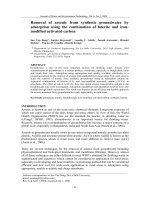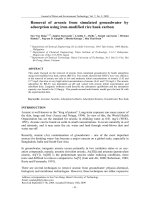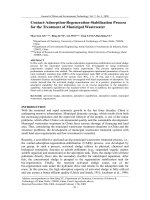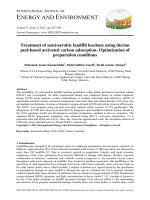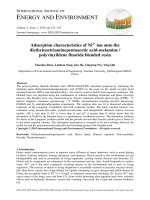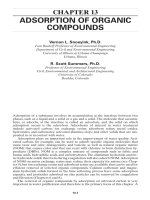adsorption
Bạn đang xem bản rút gọn của tài liệu. Xem và tải ngay bản đầy đủ của tài liệu tại đây (16.67 MB, 675 trang )
Proceedings
of
the Third Pacific Basin Conference
on
Adsorption Science
and
Technology
This page intentionally left blankThis page intentionally left blank
Proceedings
of
the
Third Pacific Basin
Conference on
Adsorption Science
and
Technology
Kyongju,
Korea
May
25-29,2003
Editor
Chang-Ha
lee
Yonsei University, Korea
re
World
Scientific
h
New Jersey London Singapore
.
Hong
Kong
Published by
World Scientific Publishing Co.
Re.
Ltd.
5
Toh Tuck Link, Singapore
596224
USA
office:
Suite
202,
1060
Main Street, River Edge,
NJ
07661
UK
oflce:
57
Shelton Street, Covent Garden, London WC2H
9HE
British Library Cataloguing-in-Publication Data
A
catalogue record for this book is available from the British Library.
ADSORPTION SCIENCE
AND
TECHNOLOGY
Proceedings
of
the Third Pacifc Basin Conference
Copyright
0
2003
by World Scientific Publishing
Co.
Re.
Ltd.
All
rights reserved. This book, or parts thereof; may not be reproduced in any form or by any means,
electronic
or
mechanical, including photocopying, recording
or
any information storage and retrieval
system now known or to be invented, without written permission from the Publisher.
For
photocopying of material in this volume, please pay a copying fee through the Copyright
Clearance Center, Inc.,
222
Rosewood Drive, Danvers,
MA
01923,
USA.
In this case permission to
photocopy is not required from the publisher.
ISBN
981-238-349-2
Printed in Singapore
The Third Pacific Basin Conference on Adsorption Science and Technology was held
fiom May
25
to May
29, 2003
in Kyongju, Korea. The theme for this conference was
“thinking about adsorption at
a
splendid, enjoyable, and sound conference.”
It
was the first time that an international conference on adsorption was ever held in
Korea. Since the previous conferences organized by Professor K. Kaneko
(1997)
and
Professor
D.
D. Do
(2000)
were very successful,
I
was very excited
as
well as very
nervous when
I
was asked to organize this conference for
I
wanted to make this one as
successful
as
the previous ones.
The main purpose of this conference was to encourage the development of new
adsorption science and technology
as
well as
to
reflect the growth of this area. The
conference covered a variety of adsorption-related fields from fundamentals to
applications. The conference consisted of plenary and invited sessions, oral sessions and
poster sessions. And the conference areas were
as
follows: Fundamentals
of
Adsorption
and lon Exchange, New Materials, Adsorption Characterization, Novel Processes, Energy
and Environmental Processes.
I
was very happy to see many contributions from
16
countries, with more than
120
papers. The plenary lectures of Professors D. D.
Do
(Univ. of Queensland, Australia),
K.
E. Gubbins (North Carolina State Univ., USA),
K.
Kaneko (Chiba
Univ.,
Japan), M.
Morbidelli (ETH Ziirich, Switzerland), A. L. Myers (Univ. of Pennsylvania, USA), D. M.
Ruthven (Univ. of Maine, USA), R. Ryoo (KAIST, Korea),
S.
Sircar (Leigh Univ. USA),
M. Suzuki (United Nations Univ., Japan), and
R.
T. Yang (Univ. of Michigan, USA) set
the tone for the theme of the conference. Also,
I
would like to thank Professors
G.
Baron,
A. Neimark, and
L.
Zhou for their contribution
as
invited speakers. Plenary speakers
presented
an
in-depth overview of key research areas: Materials, Characterization,
Molecular Simulations, Equilibria, Kinetics, and Processes. Furthermore, many
contributed papers were of high standard.
1
hope that this conference was a worthwhile
and memorable one for all the participants.
I
would like to thank all the participants for all the contributions to the conference.
I
would like
to
take this opportunity to thank all the reviewers for their efforts to review
papers within a very short period of time. Thanks should also go to the members of the
organizing committee and secretary, the advisory and scientific committee and session
chairs for their input and assistance. Also, special thanks goes to Professor J. Ritter (Univ.
of South Carolina, USA) for the organization of the US side. And
I
would like to express
my gratitude to Yeong-Joo Park, my wife, for all of her support and
I
thank my graduate
students for all of their hard work to make this conference work.
The conference would not have been possible without the generous financial support
from many organizations such as the National Science Foundation, Yonsei University,
Korean Institute of Chemical Engineers, KOSEF,
KRF,
Daesung Sanso Co., Research
Institute of New Energy and Environmental Systems at Yonsei Univ., Yonsei Center for
Clean Technology, Chonnam National University, Chungnam National University,
NRL
for Themophysical Properties, ERC for the Advanced Bioseparation Technology, NRL
for Separation Process,
NRL
for Environmental Materials
&
Process.
Professor Chang-Ha Lee
Chairman of the Third Pacific Basin Conference on Adsorption Science and Technology
Department of Chemical Engineering, Yonsei University, Korea
V
Preface
Sponsors
Yonsei University
Korean Institute
of
Chemical Engineers
The Korean Federation
of
Science and Technology Societies
Korea Science and Engineering Foundation
Korea Research Foundation
Daesung Sanso Co.
National Science Foundation
(USA)
Co-Sponsors
Research Institute
of
New Energy and Environmental Systems
at Yonsei University
Yonsei Center
for
Clean Technology
Chonnam National University
Chungnam National University
ERC
for
the Advanced Bioseparation Technology
NRL
for
Themophysical Properties
NRL
for
Separation Process
NRL
for
Environmental Materials
&
Process
vi
Conference Chair
Chang-Ha Lee (Yonsei Univ., Korea)
Conference Advisory Committee
B.
H.
Ha (Hanyang Univ.)
H.
Lee (Yonsei Univ.)
H.
K. Rhee
(Seoul National Univ.)
Organizing Committee
S.
H.
Cho (KIER)
D. K. Choi
(KIST)
S.
H.
Hyun (Yonsei Univ.)
J.
W.
Jang
H.
Kim (Seoul National Univ.)
Y.
M. Koo (Inha Univ.)
C.
S.
Lee (Korea Univ.)
H.
Moon
(Chonnam Univ.)
D.
S.
Park
S.
K.
Ryu (Chungnam Univ.)
Y.
G.
Shul (Yonsei Univ.)
J. E. Sohn (Dong-A Univ.)
J. Yi (Seoul National Univ.)
(SK
Eng.
&
Construction)
(Daesung Sanso Co.)
International Advisory Committee
A.
S.
T. Chiang
D.
D.
Do
K.
E.
Gubbins
K. Kaneko (Chiba Univ., Japan)
2.
Li
M.
Morbidelli (ETH Zurich, Switzerland)
A. L. Myers
J. Ritter
J.
L.
Riccardo (UNSL, Argentina)
D.
M.
Ruthven
H.
Tamon (Kyoto Univ., Japan)
R. T. Yang
H.
Yoshida
L. Zhou (Tianjin Univ., China)
Wational Central Univ., Taiwan)
(Univ.
of
Queensland, Australia)
(North Carolina State Univ., USA)
(South China Univ.
of
Technology, China)
(Univ.
of
Pennsylvania, USA)
(Univ.
of
South Carolina, USA)
(Univ.
of
Maine, USA)
(Univ.
of
Michigan, USA)
(Osaka Prefectural Univ., Japan)
Scientific Advisory committee
T. Bandosz
G.
Baron
M.
Bulow
G. Carta
K.
Chihara (Meiji Univ., Japan)
C.
B.
Ching
J.
Izumi
M.
Jaroniec
(The City College
of
New York, USA)
(Vrije Universiteit Brussel, Belgium)
(The BOC Group, Inc., USA)
(Univ.
of
Virginia, USA)
(The National Univ. of Singapore, Singapore)
(Mitsubishi Heavy Chem. lnd., Ltd., Japan)
(Kent State Univ.,
USA)
Vii
J.
U.
Keller
J.
M. Lee
K.
H.
Lee
N.
Lemcoff
M.
D.
LeVan
M. Mazzotti
G.
McKay
F. Meunier
J. K. Moon
A. Neimark
Y.
D.
Park
A. E. Rodrigues
W.
Rudzinski
R. Ryoo
A. Sakoda
N. Seaton
S.
Sircar
W.
A. Steele
M.
Suzuki
0.
Talu
Y. Teraoka
Y. Xie
(Univ.
of
Siegen, Germany)
(KRICT, Korea)
(Pohang Univ., Korea)
(The BOC Group, Inc., USA)
(Vanderbilt Univ., USA)
(ETH ZUrich, Switzerland)
(Hong Kong Univ.
of
Sci.
and Tech., Hong Kong)
(Laboratoire du Froid CNAM, France)
(KAERI, Korea)
(TRI/Princeton, USA)
(FUST, Korea)
(Univ.
of
d
Porto,
Portugal)
(Maria Curie-Sklodowsk Univ., Poland)
(KAIST, Korea)
(Univ.
of
Tokyo,
Japan)
(Univ,
of
Edinburgh, UK)
(Pennsylvania State Univ., USA)
(United Nations Univ., Japan)
(Cleveland State Univ., USA)
(Kyushu Univ., Japan)
(Peking Univ., China)
(USA)
Organizing Secretary
C.
H.
Cho (Youngdong Univ.)
S. S.
Han (KIER)
K.
T.
Lee (Yonsei Univ.)
J.
Y.
Yang
(SK Eng.
&
Construction)
Vlll
Contents
Preface
V
Plenary Papers
Adsorption Equilibria
of
Sub-critical and Super-critical Fluids in
Carbonaceous Materials
FreezingMelting in Porous Carbons
D. D. Do and H. D.
Do
E
R. Hung, R. Radhakrishnan,
E
Beguin,
M.
Sliwinska-Bartkowiak
and
K.
E.
Gubbins
9
1
Measurement of Diffusion in Microporous Solids
D.
M.
Ruthven
17
Ordered Mesoporous Carbons with New Opportunities for Adsorption
Studies
R. Ryoo and
S.
H.
Joo
T
Tanaka,
I:
Hattori,
K.
Murata,
T.
Kodaira,
M.
Yudasaka,
27
Quantum Micropore Filling and its Application Possibility
S.
I@ma and
K.
Kaneko
35
Adsorption in Microporous Materials: Analytical Equations for TYPE
I
Isotherms at High Pressure
New Sorbents for Desulfurization
of Transportation Fuels
A.
L.
Myers
44
R. T.
Yang,
A.
Hernandez-Maldonado,
A.
Takahashi and
E
H.
Yang
51
Optimization of Continuous Chromatography Separations
Adsorption Technology for Gas Separation
2.
Y.
Zhang,
M.
Mauottiand
M.
Morbidelli
S.
Sircar
64
72
Carbon Composite Membranes
M.
Suzuki,
A.
Sakoda,
S D.
Bae,
T
Nomura and
Y Y.
Li
79
Invited
Papers
On
the
Dominant Role
of
Adsorption Effects
in
Heterogeneous
Catalysis
J.
E
Denayer, G.
V
Baron, D. Devos,
J.
A.
Martens
and
R
A.
Jacobs
87
iX
Supercritical Adsorption: Paradox, Problems, and Insights
Contributed
Papers
Microwave Drying for Preparation
of
Mesoporous Carbon
H.
Tamon,
T.
Yamamoto,
T.
Suzuki and
S.
R.
Mukai
Computer Simulation of Transport in Cylindrical Mesopores
S.
K.
Bhatia and
D.
Nicholson
Multicomponent Mass Transfer Diffusion Model for the
Adsorption
of
Acid Dyes on Activated Carbon
K.
K.
H.
Choy,
J.
E
Porter and G. McKay
Sorption Thermodynamics
of
Nitrous OxideLSX Zeolite Systems
M.
Biilow,
D.
Shen and
S.
R.
Jale
Activated Carbon Membrane with Carbon Whisker
S D.
Bae and
A.
Sakoda
Mesoporous Silica with Local MFI Structure
L.
Zhou
S.
P.
Naik,
A.
S.
T.
Chiang,
R.
W
Thompson,
E
C.
Huang
and
H M.
Kao
Infinite Dilution Selectivity Measurements by
Gas
Chromatography
Adsorption Properties of Colloid-Imprinted Carbons
On the Role of Water in the Process of Methyl Mercaptan
Adsorption on Activated Carbons
Studies on the Adsorption Properties of Ion-Exchanged Low Silica
X
Zeolite
S.
Gumma and
0.
Talu
M.
Jaroniec and
2 J.
Li
S.
Bashkova,
A.
Bagreev and
T.
J.
Bandosz
H.
Jiang,
W
Tang,
J.
P.
Zhang, B.
I!
Zhao and
I!
C. Xie
Carbonization of Organic Wastes Using Super-Heated Water Vapor
and Their Adsorption Properties
Further Successful Applications of the New Theoretical
Description of Adsorptioflesorption Kinetics Based on the
Statistical Rate Theory
Characterization and Ethylene Adsorption Properties of
Silver-Loaded FER Zeolite Potentially Used
as
Trap Material
of Cold-Start Hydrocarbon Emission from Vehicles
H.
Yoshida,
N.
Miyagami and
M.
Terashima
#?
Rudzinski and
T.
Panczyk
I!
Teraoka,
H.
Onoue,
H.
Furukawa,
I.
Moriguchi,
H.
Ogawa
and
M.
Nakuno
91
99
104
109
114
121
126
131
136
141
147
152
157
162
X
Pressure-Dependent Models for Adsorption Kinetics on a CMS
Z-S.
Bae,
I!-K.
Ryu and
C H.
Lee
167
Preparative Enantioseparation
of
Fluoxetine by Simulated
Moving Bed
H W
Yu
and
C.
B. Ching
Optimization Based Adaptive Control of Simulated Moving Beds
G. Erdem,
S.
Abel, M. Mauotti, M. Morari and
M.
Morbidelli
Mono-Methyl Paraffin Adsorptive Separation Process
Chromium
(VI)
and (111) Species Adsorption from Aqueous Solutions
by Activated Carbon Fibers
Treatment of Complex Wastewaters by Biosorption and Activated
Carbon: Batch Studies
C.
Gerente,
2.
Reddad,
Z:
Andres,
C.
Faur-Brasquet
and
I?
le Cloirec
S.
Kulprathipanja,
J.
Rekoske,
M.
Gutter and
S.
Sohn
0.
Astachkina, A. Lyssenko and
0.
Muhina
Adsorption Characteristics
of
Protein-Based Ligand for Heavy Metals
Preparative Chromatography at Supercritical Conditions
Adsorptive Separation
of
Oligosaccharides: Influence of
Crosslinking of Cation Exchange Resins
Identification and Predictive Control of a Simulated Moving
Bed Process
M.
Terashima,
N.
Oh,
T.
Sei,
K.
Shibata and
H.
Yoshida
A.
Rajendran,
M.
Mauotti and
M.
Morbidelli
J.
A.
Vente,
H.
Bosch,
A.
B. de Haan and
P.
J.
T.
Bussmann
I H.
Song, H K. Rhee and
M.
Mazzotti
H.
Fujita,
T.
Fujii,
A.
Sakoda and
J.
Izumi
Quick and Compact Ozonation Using Siliceous Zeolite
Time Resolved Multicomponent Sorption
of
Linear and Branched
Alkane Isomers on Zeolites, Using NIR Spectroscopy
A.
F:
P.
Ferreira,
M.
Mittelmeijer,
M.
Schenk, A. Bliek
and B. Smit
Pore Size Effects in the Liquid Phase Adsorption
of
Alkanes
in Zeolites
J.
F:
M.
Denayer,
K.
de Meyer,
J.
A.
Martens and
G.
K
Baron
Detection
of
Freezing Point Elevation in Slit Nanospace by
Atomic Force Microscopy
M. Miyahara,
M.
Sakamoto,
H.
Kanda and
K.
Higashitani
172
177
182
189
194
199
204
209
214
219
224
229
234
xi
Modeling of High-pressure Equilibrium Adsorption
of
Supercritical
Gases on Activated Carbons. Determination of Pore Size
Distribution Using a Combined DFT and
EOS
On the Peculiarity of the Minimum of N-Hexane Permeability in
Activated Carbon
Simplified Experimental Method to Analyse Intra-Activated
Carbon Particle Diffusion Based on Parallel Diffusion Model
I:
Miura,
I:
Otake,
H.
T.
Chang,
N.
Khalili,
S.
Iwasawa
and
E.
G.
Furuya
In-Situ Characterization of Ion Adsorption at Biomimetic
Airwater Interfaces
Single and Multi Component Adsorption of Volatile Organic
Compounds onto High Silica Zeolites
-
Discussion of
Adsorbed Solution Theory
I?
Monneyron,
M.
-H.
Manero and
J.
-N.
Foussard
E. A. Ustinov and D. D. Do
J S. Bae and D. D. Do
T.
E
Kim,
G.
S.
Lee and D.
J.
Ahn
239
244
249
254
259
Influence of VOCs Molecular Characteristics on Exothermicity
of Adsorption onto Activated Carbon
The Influence of
Ar
and He on the Rate of Adsorption and on the
Adsorption Equilibrium of Alkanes in Zeolites
M.
C,
Mittelmeijer-Hazeleger, A.
E
l?
Ferreira
and
A. Bliek
Modeling the Discharge Behavior of Metal Hydride Hydrogen
Storage Systems
The Advanced Modeling Technology for Periodic Adsorption
Process: Direct Determination of Cyclic Steady State
l?
Pre,
C.
Faur-Brasquet and
I?
le Cloirec
264
270
S.
A.
Gadre, A. D. Ebner,
S.
A. Al-Muhtaseb and
J.
A. Ritter
276
J H.
Yun, A.
C.
Stawarz and
E
0.
Jegede
28
1
Adsorption and Desorption Characteristics of Zeolite Impregnated
Ceramic Honeycomb for VOC Abatement
H S.
Kim,
l!-J.
Yoo,
E-S.
Ahn,
M K.
Park,
K T.
Chue
and
M H.
Han
Reverse Flow Adsorption Technology for the Recycling of
Homogeneous Catalysts: Selection
of
Suitable Adsorbents
Molecular Simulation of Gas Separation by Adsorption Processes
J.
Dunnewijk,
H.
Bosch and A. B. de Haan
J.
I?
B. Mota
286
29
1
296
xii
Metal-Doped Sodium Aluminium Hydride
as
a Reversible
Hydrogen Storage Material
Synthesis and Dehumidification Behaviors of Monodisperse Spherical
Silica Gels with Different Pore and Chemical Structures
C,
H.
Cho,
Y.
J.
Yoo,
J.
S.
Kim,
H.
S.
Kim,
Y.
S.
Ahn
and
M.
H.
Han
Production of Hard Carbons
for
Lithium Ion Storage by the
Co-Carbonization of Phenolic Resin Precursors
S.
R. Mukai, T. Tanigawa,
T
Harada,
T.
Masuda and
H.
Tamon
Novel Bioactivite Carbomineral Sorbents, Including Cluster
and Carbon Nanotubes for Superselective Purification of Biodiesel
Fuel
-
Liquid Hydrocarbons and Carbonhydrate from
Sulfur
Containing Impurities
D.
I.
Shvets
Titanosilicate ETS-10: Synthesis, Characterization and Adsorption for
Heavy Metal Ions
Ordered Macroporous Materials Structurally Templated by Colloidal
Microspheres
Adsorption of Nitrogen, Oxygen and Argon in Transition and Rare
Earth Ion Exchanged Zeolites
A
and
X
R.
K
Jasra,
J.
Sebastian and
C.
D.
Chudasama
Adsorption of Methylene Blue from Water onto Activated Carbon
Prepared from Coir Pith, an Agricultural Solid Waste
Separation of Oxygen- Argon Mixture by Pressure Swing Adsorption
Dual Reflux Pressure Swing Adsorption Cycle for
Gas
Separation
and Purification
Simulation of a Coupled MembranePS
A
Process for Gas Separation
I3CO
and
l2C0 Separation on Na-LSX using Pressure-Swing Adsorption
at
Low Temperatures
J.
Wang,
A.
D.
Ebner,
K.
R.
Edison,
J.
A. Ritter and
R.
Zidan
G.
X.
S.
Zhao,
J.
L.
Lee and
f?
A.
Chia
Z. Zhou,
?-I?
C.
Ong
and
G.
X.
S.
Zhao
C.
Namasivayam and
D.
Kavitha
X.
Jin and
S.
Farooq
A.
D.
Ebner and
J.
A.
Ritter
I.
A.
A.
C. Esteves and
J.
I!
B.
Mota
J.
Izumi,
N.
Fukuda,
N.
Tomonaga,
H.
Tsutaya,
A.
Yasutake,
A. Kinugasa and
H.
Saiki
30
1
306
313
318
324
329
334
339
344
349
354
359
xiii
High Purity Oxygen Generation PSA Process by Using Carbon
Molecular Sieve
A Study on the Preparation of Deodorizing Fibers by Coating TiOz
Composite Adsorbents for the Removal of Cs and Sr Ions in
Acidic Solutions
J.
K. Moon,
C.
H.
Jung,
S.
H.
Lee,
E.
H.
Lee,
H.
T.
Kim
and
I!
G.
Shul
J G. Jee, T-H. Kwon and C H. Lee
S.
W
Oh,
H.
J.
Kim and
S.
M.
Park
Dehumidification Behavior
of
Metal(Ti, Al, Mg) Silicates
Impregnated Ceramic Fiber Sheets
I!
S.
Ahn,
C.
H. Cho,
I!
J.
Yoo,
J.
S.
Kim,
H.
S.
Kim
and
M.
H.
Han
Synthesis of Zirconia Colloids from Aqueous Salt Solutions
and Their Applications
Comparison of Nano-Sized Amphiphilic Polyurethane (APU)
Particles with SDS, an Anionic Surfactant for the Soil Sorption
and the Extraction
of
Phenanthrene from Soil
Synthesis of Mesoporous Activated Carbon with Iron Ion-Aided
Activation
Separation
of
Peptides from Human Blood by RP-HPLC
Separation of Acanthoside-D in Acanthopanax Senticosus by
Preparative Recycle Chromatography
Use of
Various
Forms
of &aft Lignin for Toxic Metal Uptake
Removal of Uranium Ions in Sludge Waste by Electrosorption
Process
C H.
Jung, J K. Moon, S H. Lee,
Z-G.
Shul and
W-Z.
Oh
Ion
Exchange Characteristics
of
Palladium from
a
Simulated
Radioactive Liquid Waste
S H.
Lee, C H. Jung,
J K.
Moon,
J.
H.
Kim and
H.
Chung
Application of Characterization Procedure for Complex Mixture
Adsorption in Water and Wastewater Treatment
S H.
Kim,
T W
Kim,
D L.
Cho,
D H.
Lee and
H.
Moon
K.
Lee,
P.
W
Carr and A.
V
McCormick
I.3.
Ahn, H S. Choi and
J Z
Kim
Z
Seida,
K.
Watanabe and
Y:
Nakano
S K. Lee,
I!
Polyakova and
K H.
Row
S.2
Hong,
D X.
Wang and
K H.
Row
D.
R.
Crist, R.
H.
Crist and
J.
R. Martin
365
370
375
38
1
387
392
398
403
408
413
417
422
427
xiv
Surface Characteristics of MCM-41 on Cr(1II) and Cr(V1)
Adsorption Behaviors
Influence of Anodic Oxidation of Activated Carbon Fibers
on the Removal of Heavy Metal in Aqueous Solution
Kinetics and Diffusion Processes for Reactive Dye Adsorption
by Dolomite
Permeate Flux Behavior During Microfiltration of Protein-Adsorbed
Microspheres in Stirred Cell
Surface Fractional Dimensions of the Adsorbents from Industrial
Sludge
Adsorption of Acidic Peptide on Crosslinked Chitosan Fiber:
Equilibria
Removal of Salt and Organic Acids from Solution used to Season
Salted Japanese Apricots
(Ume)
by Combining Electrodialy sis
and
Adsorption
Studies on the One-Column Analogue of a Four-Zone SMB
Advanced' Flue Gas Treatment by Novel de-SOX Technology over
Active Carbon Fibers
Adsorption
of
Natural Gas Components on Activated Carbon
for
Gas Storage Applications
S.
J.
Park,
B.
R.
Jun
and
M.
Han
S.
J.
Park,
I!
M.
Kim and
J.
R.
Lee
S.
J.
Allen,
G.
M.
Walker,
L.
Hansen and J A. Hanna
I:
Chang,
S W
Choi,
T-G.
Lee,
S.
Haam and
W-S.
Kim
J.
H. You,
H.
M.
Wu and
2.
X.
Fang
N.
Kishimoto and
H.
Yoshida
W
Takatsuji and H. Yoshida
Y.
S.
Kim, C. H. Lee,
Y.
M.
Koo and
I?
C. Wankat
M A. Yoshikawa,
A.
Yasutake and
I.
Mochida
I.
A. A.
C.
Esteves,
M.
S.
S.
Lopes,
I?
M.
C.
Nunes,
M.
E
J.
Eusibio,
A.
Paiva and
J.
I?
B.
Mota
Prediction of Breakthrough Curves for Toluene and
Trichloroethylene onto Activated Carbon Fiber
J M?
Park,
S S.
Lee,
X-W
Lee and
D K.
Choi
Catalytic Reduction Mechanism of Nitric Oxide over
ACFslCopper Catalyst
S.
J.
Park,
B.
J.
Kim
and
X
S.
Jang
432
437
442
447
452
458
463
468
474
479
484
489
xv
NO
Removal of Activated Carbon Fibers Treated by Cu
Electroplating
The Appliance Study
of
02-PSA
in the Oxygen Activated
Sludge Process
Application of Solid Adsorbent for VOC Monitoring Sensor
PSA for Solvent Recovery with USY-Type Zeolite;
an
Experimental and a Simulation Study
K.
Chihara,
T.
Kaneko,
T.
Aikou
and
S.
Oh
Azeotropic Adsorption of Organic Solvent Vapor Mixture on
High Silica Zeolite, Experimental
&
Simulation
S.
J.
Park,
J.
S.
Shin and
J.
R.
Lee
S.
H.
Lee,
P.
S.
Yong,
H.
M. Moon
and
D.
S.
Park
0.
J.
Joung and
E
H.
Kim
K.
Chihara,
K.
Hijikata,
H.
Yamaguchi,
H.
Suzuki
and
E
Takeuchi
VOC Enrichment by a VSA Process with Carbon Beds
J.
Yang,
M.
Park, J W Chang and C H. Lee
Isobutane Purification by Pressure Swing Adsorption
S.4.
Han,
J H.
Park,
J N.
Kim and S H. Cho
Characteristics of Gas Separation by Using Organic Ternplating
Silica Membrane
Adsorber Dynamics of Binary and Ternary Hydrogen Mixture
in Activated Carbon and Zeolite
5A
Beds
J.
Moon,
S.
Hyun and C H. Lee
M B.
Kim, J S. Kim,
C H.
Cho and C H. Lee
Temperature Programmed Adsorption (PA)
of
Various
Hydrocarbons
on Adsorbers of Honeycomb Type
D.
J.
Kim,
J.
E.
fie,
E
S.
Oh and
J.
M.
Kim
Non-Isothermal Dynamic Adsorption and Reaction in
Hydrocarbon Adsorber System
D.
J.
Kim,
W.
G.
Shim,
J.
E.
Yie and
H.
Moon
Sorption
of
U(V1) onto Granite: Kinetics and Reversibility
M.
H.
Baik and
P.
S.
Hahn
Adsorption of Uranium (VI) on Kaolinite: Speciation
and Mechanism
High-Temperature Adsorption of Hazardous Metal Chlorides
Using Activated Kaolinite
M.
J.
Kang,
B.
E.
Han and
P.
S.
Hahn
H.
C. Yang,
J.
S.
Yun,
E
J.
Cho and
J.
H.
Kim
494
499
504
509
514
519
524
529
534
539
544
549
554
559
xvi
Probing the Cut-Off for Intracrystalline Adsorption on Zeolites:
Pore Mouth Adsorption
R. Ocakoglu,
J.
E
M.
Denayer,
J.
A.
Martens,
G.
B. Marin
and
G.
I!
Baron
The Low-Temperature Sorption Behaviour
of
Cryosorbent Materials
Thermal and Surface Mechanism Studies on
Adsorption-Temperature Programmed Desorption of Nitrogen
Oxides over Chemically Activated Carbon Fiber
H J.
Kim,
X-W
Lee,
E.
Lee and D K. Choi
Surface Properties of Activated Carbons Containing Basic
Hydroxide Ions and
NOx
Adsorption-Desorption Process
C.
Day and
I!
Hauer
X
W
Lee,
H. J.
Kim, D. K. Choi,
J.
W
Park C.
H.
Lee
and B.
K.
Na
Adsorption Characteristics of Nitrogen Compounds on Silica Surface
Adsorption Characteristics of VOCs on Mesoporous Sorbents
W
G.
Shim, M.
S.
Yang,
J.
W
Lee,
S.
H.
Suh and
H.
Moon
Molecular Simulation
for
Adsorption of Halocarbons in Zeolites
K.
Chihara,
T.
Sasaki,
S.
Miyamoto, M. Watanabe,
C.
E
Mellot-Draznieks and
A.
K.
Cheetham
H.
J.
Kim,
C H.
Lee,
X
G.
Shul and
W
S.
Min
Adsorption of BTX on MSC in Supercritical
C02,
a Chromatographic
Study
K.
Chihara,
N.
Omi,
E
Znoue,
T
Yoshida and
T
Kaneko
Porous Alumina with Bimodal Pore Size Distribution as an
Organic Adsorbent
I:
Kim,
C.
Kim,
P
Kim,
.I.
C.
Park and
J.
yi
Storage and Selectivity
of
Methane and Ethane into
Single-Walled Carbon Nanotubes
Hydrotalcites for Carbon Dioxide Adsorbents at High Temperature
Effect of Polarity of Polymeric Adsorbents on Desorption
of
VOCs under Microwave Field
X-G.
Seo, B.
H.
Kim and
N.
A.
Seaton
J.
I.
Yang,
M.
H.
Jung,
S H.
Cho and
J N.
Kim
X.
Li,
2.
Li,
H.
X.
Xi and
H.
Wang
Mixed-Gas Adsorption on Heterogeneous Substrates in the Presence
of Lateral AD-AD Interactions
A.
J.
Ramirez-Pastor,
E
M.
Bulnes and
J.
L.
Riccardo
564
569
574
579
5
84
589
595
600
605
610
615
620
625
xvii
Adsorption on Correlated Disordered Substrates
R.
H.
Lopez,
E
M.
Bulnes,
E
Rojas,
J.
L.
Riccardo
and
G.
Zgrablich
Temperature Effects on the Scaling Properties of Adsorption
on Bivariate Heterogeneous Surfaces
Adsorption of Polyatomic
Species:
An
Approach from
Quantum Fractional Statistics
J.
L.
Riccardo,
A.
J.
Ramirez-Pastor and
E
Rom’
Multilayer Adsorption with Multisite-Occupancy
E
Rom’,
A.
J.
Ramirez-Pastor and
J.
L
Riccardo
E
Rom*,
E
Bulnes,
A.
J.
Ramirez-Pastor and
G.
Zgrablich
630
635
640
645
xviii
Plenary Papers
This page intentionally left blankThis page intentionally left blank
ADSORPTION EQUILIBRIA
OF
SUB-CRITICAL AND SUPER-CRITICAL
FLUIDS IN CARBONACEOUS MATERIALS
D.
D. DO
AND
H.
D.
DO
Department
of
Chemical Engineering, University
of
Queensland, St. Lucia, Qld
4072,
Australia
E-mail:
In this paper, we present an overview
of
a
number of techniques used to characterize the adsorption
equilibria
of
sub
and super-critical fluids in nonporous carbon black and porous activated carbon.
Tools
such
as
the grand canonical Monte Carlo simulation (GCMC), Density Functional
Theory
(DFT), Molecular Layer Structure
Theory
(MLST)
of
Ustinov and
Do,
and enhanced molecular
layering and pore filling proposed
by
Do and his co-workers
will
be
discussed. Although the GCMC
provides the brute force calculation
of
molecular interactions and its results have been
used
as
a
benchmark for other techniques to compare with, its extremely time consuming computation makes
the other techniques more appealing
to
engineers and experimentalists. Despite the ever-increasing
computing power of today personal computer, the advantage
of
simpler methods is warranted for
their role in solving practical problems. Furthermore, added to this advantage
is
the
good
perfarmance
in
terms
of
the
prediction power
of
the
simpler methods.
AN these tools will
be
discussed in this
paper
regarding their applications to adsorption
of
super
and sub-critical fluids in
carbonaceous materials, such
as
graphitid thermal carbon black and activated carbon.
1
Introduction
Adsorption equilibria and kinetics are important for the proper design of adsorption
processes. The equilibria information of adsorption isotherm. is clearly the first hand
information that one needs to approximately size the adsorber.
Since the adsorption
affinity can vary by many orders of magnitude.
Ranging from very low for weakly
adsorbing gases to very high for strongly-adsorbing hydrocarbon vapours, it is very
important that we know the value of this adsorption affinity.
Experimentally this
information can be obtained from careful experimentation of adsorption isotherm
measured from very low pressure (where adsorption affinity can be calculated) to very
high pressure where saturation capacity can be determined. Alternatively, the adsorption
affinity can be determined from some appropriate theories
or
computer simulation. With
the advances of high speed computer and the development of modem tools to deal with
inhomogeneous fluids in confined space such
as
micropores, the second approach is
gaining ground and new theories are constantly developed allowing engineers and
scientists to calculate adsorption isotherm from
minimum
amount of information.
Nevertheless, that does not mean to say that we can make do without experimental data.
We still have some ground to cover before that stage can be reached. At the present time,
careful and reliable experimental data are still required for validation of theories and even
confirmation
of
molecular simulations.
In
this paper we will discuss some modem tools for studying adsorption equilibria of
super and sub-critical fluids
on
non-porous surface and
in
porous carbons.
In
particular,
the tools of grand canonical Monte Carlo (GCMC) simulation
[l,
21,
Density Functional
Theory
[3],
Molecular Layer Structyre Theory (MLST)
[4,
51,
and the enhanced
molecular layering and pore filling of
Do,
first developed in
1998
[6]
and later applied in
a number of practical systems
[7-101,
will be discussed. Their applications to
experimental systems are illustrated to highlight the advantages and disadvantages of
these modem tools of equilibria characterization.
1
2
Tools
of
characterisation
2.
I
In the molecular simulation of adsorption in confined space such
as
pores
of adsorbent,
the most widely used and successful ensemble is the grand canonical Monte Carlo
simulation. In this ensemble, we specify the chemical potential
of
the fluid,p, that the
candidate pore is immersed
in,
the size of the pore, and the temperature.
In the GCMC, the simulation can be carried out
in
the same procedure suggested by
Metropolis at al.
[
111, and the density distribution (hence average pore density) can be
obtained
as
a
direct result of the simulation. The GCMC simulation is usually carried
out
by starting with a very low value of chemical potential. Once the simulation
corresponding to this chemical potential has been completed, the chemical potential is
increased incrementally and the particle configuration of the last run is used as the initial
configuration and the new simulation is then carried out. This process
is
repeated until
the final chemical potential is performed.
In
the simulation, the simulation box is
constraint by the width
of
the pore and the
L,
and
L,
in the
x
and
y
directions. The box
lengths
L,
and
L,
are chosen large enough, and usually chosen
as
twice the cut-off
distance. In
our
work we choose
r,
=
5ofi
and periodic boundary conditions are applied
in
the
x
and
y
directions. The procedure
of
the GCMC involves three basic moves:
1. DisDlacement
of
Darticle:
A
particle is selected in random and is given a new
conformation (translation and rotation). The move is accepted with a probability
where AU is the difference between the new and old configuration energies.
In
this
move the displacement step and the rotation angle are chosen
in
such a manner that
the acceptance rate is between
25
and
50%.
2.
Insertion
of
Darticle: The second move is the particle insertion move.
A
particle is
generated at a random position. Its acceptance must satisfy the probability:
Grand canonical Monte Carlo simulation
p
=
min[l, exp( -AU
/
kT)]
-
-
p=
min
1,
1
exp&
-
U(N
+
1)
+
U(N)]/ kT)
A~(N+~)
where
V
is the volume of the simulation box and
A
is the thermal de Broglie
wavelength. Usually in the simulation we supply the activity,
z
=
A-’
exp(p/ kT)
,
instead of the chemical potential.
For
bulk gas phase which behaves
as
an ideal gas,
this activity is the density
of
the gas phase.
3.
Removal
of
Darticle: The third move
in
the GCMC simulation is the removal
of
a
particle.
A
particle
is
chosen in random and removed. The probability
of
acceptance
this removal is
The
GCMC
is successfully applied to many adsorption systems.
For
temperatures
greater than the pore critical temperature, the adsorption isotherms exhibit a smooth
behaviour. However, for temperatures less than the pore critical temperature, there is
a possibility of transition. When there is transition, the equilibrium point may be
obtained by applying the thermodynamic integration method
[
121.
2
2.2
Density
Functional
Theory
(DFT)
The DFT method was popularized in the sixty and was increasingly modified and applied
to many problems involving inhomogeneous fluids in the
80s.
Among the many versions
of DFT, the one proposed by Tarazona and co-workers
[3]
remains the popular one in
solving adsorption of confined fluid
in
pores. Their method is the non-local DFT and
is
applied on a grand canonical ensemble.
The starting point
of
the method is the grand
potential of the system
=
F(p(l))
+
jP@)ucxtcr)dx
-
jP@>P&
(la)
where
p(rJ
is the singlet particle density. The first term on the
RHS
of
the above equation
is the Helmholtz free energy of the system. The Helmholtz free energy
is
expressed
as
a
sum
of
two
terms. The first term is that obtained from a reference system (hard sphere
fluid is chosen
as
one) and the other is the perturbed component (which is due to the
attractive component of the intermolecular fluid-fluid interaction), that is
The Helmholtz free energy of the reference hard sphere system, in
turn,
can be expressed
as
two
terms. One is due to the ideal gas contribution (accounting for the momenta
of
all
particles) while the other term is the repulsive interaction among the hard spheres. It is
where the smoothed density is given by
Assuming a mean field approximation, the perturbed component of the Helmholtz free
energy due to the attractive force is
F(PCr))
=
FH
(P@N
+
FA-
(PO
FH
(P(E))
=
jP@
[In(A3
P(IN
-
11
dr
+
jP(0
fm
G(IN
dI
-
P(I)
=
IPW
w(x-il;p(l))dzI
FA-(P(I))
=?
jjP0
PW
%(I-d)dd dx
(1b)
1
The equilibrium density profile can then be obtained by finding minimum of the grand
potential
as
defined in eq.(la). Tarazona used the Carnahan-Starling equation
to
derive
the excess function f”(p(I))
as
(here, d is the hard sphere diameter)
f”(&))
=
(4y
-3~‘)
/(I
-
y)’
;
y
=
(nd’
16)
&)
2.3
The Molecular Layer Structure Theory (MLST) was first developed
[4,
51
to study the
vapour liquid equilibrium and surface tension
of
many substances over a wide range of
temperature.
In
this method, the fluid
is
considered
as
parallel molecular layers, whose
surface densities are different for inhomogeneous fluids. Similar
to
the DFT method, we
Molecular Layer Structure Layer
Theoty
(MLST)
-
define
the following grand potential:
R
=
cp;k(p;)+cpj
+urf
-
jl]
i
where
py
is the surface density,
Ask)
is the intrinsic Helmholtz free energy of the layer
j,
‘pj
is the interaction energy between one molecule on the layerj and all surrounding
layers, and u;‘
is
the external potential exerted on the layerj. In this method of MLST,
the intrinsic Helmholtz free energy is calculated from the equation of state of
homogeneous
fluid,
and
‘pi
is calculated
from
the integration
of
12-6
Lennard-Jones
3
potential energy. The equilibrium density is calculated by minimizing the grand potential
with respect
to
density
as
well
as
distances between layers
[4,5].
2.4
The
Do-Method
Recently,
Do
and co-workers
[6-101
have proposed a very simple method but it does
reveal the mechanistic pictures of what are occurring in pores of different size. The
process of adsorption in pore is viewed
as
follows. Molecules
in
pore are constantly
in motion but “statistically” there is
a
spatial distribution of these molecules due to the
interactive forces between them and the surface atoms. We treat this spatial distribution
as
a step function; uniformly high density near the surface and uniformly low density
in
the inner core of the pore. Due to the long range interaction of the surface, the pressure
of the fluid in the inner core is not the same
as
that in the bulk phase. Assuming a
Boltzmann distribution, the pressure
of
the inner core is related to the bulk fluid as
Pp
=
P.exp(-
a
E/
kT)
(2)
where
E
is the average potential
of
the inner core, which is a function of pore width and
the layer thickness. The adsorption process is basically treated
as
a molecular layering
process, and it can be described by a layering equation,
for
example an equation taking
the form
of
the BET equation. The affinity parameter
C,
of
this
equation the same
as the C-parameter for a flat surface. Rather they are related through the following
relation
where
Q
is the heat
of
adsorption
of
the flat surface and
Qp
is
the corresponding value
for
a pore. These values may be taken
as
the minimum value of the potential energy between
a molecule and a flat surface and that between a molecule and a pore. The layering
equation can be written
as
where
t,,,
is the thickness of a monolayer. This layering process is followed by a pore
filling process. Here the term ‘pore filling’ is used in its most general sense, that
is
pore
is
filled with molecules by either two-dimensional condensation in small pores
or
three
dimensional condensation in large pores. We argue that
this
general pore filling process
is
governed by the equation
c,(H)
=
c.~xP[(Q,(H)-Q)/RT~
(3)
t
/
t,
=
f(P,
(HI,
c,
(HI)
(4)
H/2-t-~,
=
*)
where
~0
is the position at which the solid-fluid potential energy is zero. Although this
form is similar to that of the Kelvin equation, the significant difference rests on the use
of
the pore pressure
P,
in the above equation.
If
we substitute the pore pressure of eq.(2)
into the above equation, we get
PM
(H/2
-
t
-
2,)
For
small pores,
E(H)
dominates the RHS
of
the above equation and hence the pore
filling pressure
in
small pores is dominated by the strength
of
the potential field created
by the overlapping of the fields of the two walls. On the other hand, for larger pores
where &H)
=
0,
the
RHS
is dominated by surface tension and this equation reduces to
the well known modified Kelvin equation.
4


